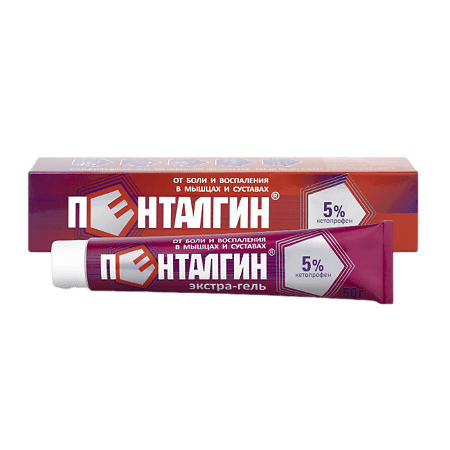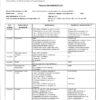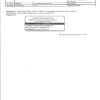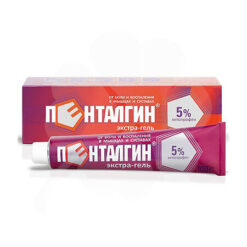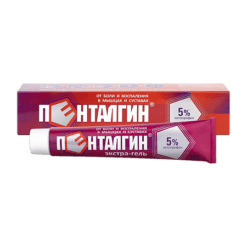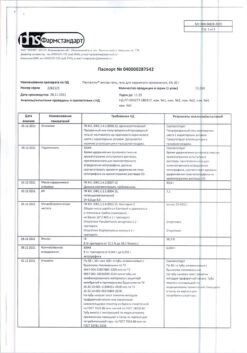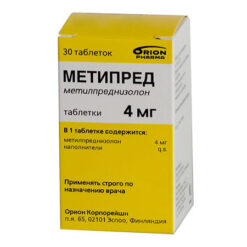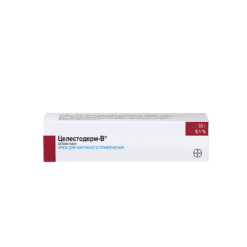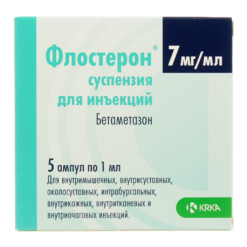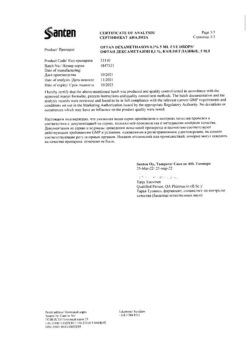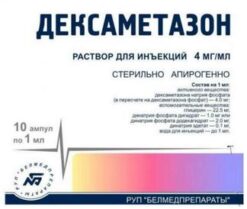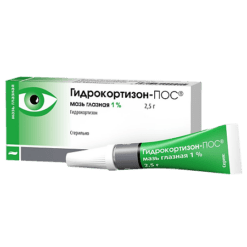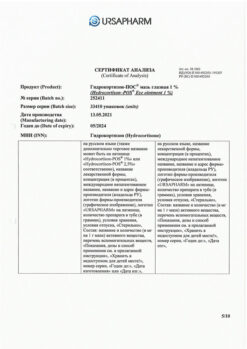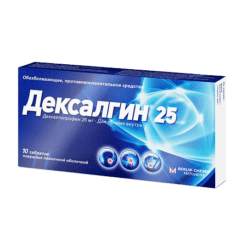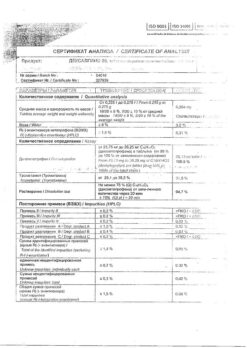No products in the cart.
Pentalgin Extra, gel 5% 50 g
€9.98 €9.59
Description
Pharmacotherapeutic group: Non-steroidal anti-inflammatory agent for local use.
The ATX code: M02AA10
Pharmacological properties
Pharmacodynamics
Ketoprofen is a non-steroidal anti-inflammatory drug; when used topically it has analgesic, anti-inflammatory and anti-edema effects. The mechanism of action is associated with inhibition of the activity of cyclooxygenase 1 and cyclooxygenase 2 enzymes that regulate the synthesis of prostaglandins.
When used as a gel it provides local therapeutic effect on the affected joints, tendons, ligaments, muscles. In joint syndrome it reduces pain in the joints at rest and when moving, morning stiffness and joint swelling. It has no damaging effect on joint cartilage.
The adjuvant tincture of the chilli pepper and camphor may have a mild warming effect at the site of application.
The excipients in the composition of dimethyl sulfoxide increase penetration of the medicines through the skin.
Pharmacokinetics
When applied topically as a gel, it penetrates through the skin to the site of inflammation and is absorbed from the site of inflammation extremely slowly and almost does not cumulate in the body. Bioavailability of ketoprofen is about 5%. After external use with a dose of 50-150 mg, plasma concentration after 5-8 hours is 0.08-0.15 mcg/ml.
Indications
Indications
Acute and chronic inflammatory diseases of the musculoskeletal system (inflammatory damage to ligaments and tendons, osteoarthritis, osteochondrosis with radicular syndrome, radiculitis, bursitis, sciatica, lumbago, articular syndrome with exacerbation of gout);
muscle pain of rheumatic and non-rheumatic origin;
post-traumatic inflammation of soft tissues and the musculoskeletal system (damage and rupture of ligaments, bruises).
The drug is intended for symptomatic therapy, reducing pain and inflammation at the time of use, and does not affect the progression of the disease.
Pharmacological effect
Pharmacological effect
Pharmacotherapeutic group: non-steroidal anti-inflammatory drug for topical use.
ATX code: M02AA10
Pharmacological properties
Pharmacodynamics
Ketoprofen is a non-steroidal anti-inflammatory drug that, when applied topically, has an analgesic, anti-inflammatory and anti-edematous effect. The mechanism of action is associated with suppression of the activity of the enzymes cyclooxygenase 1 and cyclooxygenase 2, which regulate the synthesis of prostaglandins.
When used in the form of a gel, it provides a local therapeutic effect on affected joints, tendons, ligaments, and muscles. For articular syndrome, it reduces joint pain at rest and during movement, morning stiffness and swelling of the joints. Does not have a damaging effect on articular cartilage.
The tincture and camphor included in the excipients of capsicum can have a slight warming effect at the site of application.
Dimethyl sulfoxide, which is part of the excipients, enhances the penetration of drugs through the skin.
Pharmacokinetics
When applied topically in the form of a gel, it penetrates into the source of inflammation through the skin and is absorbed from the site of inflammation extremely slowly and practically does not accumulate in the body. The bioavailability of ketoprofen is about 5%. After external use at a dose of 50-150 mg, the plasma concentration after 5-8 hours is 0.08-0.15 mcg/ml.
Special instructions
Special instructions
The gel should be applied only to intact areas of the skin, avoiding contact with open wounds, eyes and mucous membranes.
After applying the drug, you must wash your hands.
The formation of a transparent film on the skin at the site of application of the gel is allowed.
Do not use with occlusive dressings.
Can be used for phonophoresis.
When applied to the skin, you may experience a feeling of warmth and, in rare cases, a burning sensation in the area of application, which may be associated with the warming effect of capsicum tincture and camphor.
Long-term use of topical products may lead to increased sensitivity and symptoms of skin irritation at the site of application.
To avoid manifestations of photosensitivity, it is recommended to avoid exposure of the skin to direct sunlight during the course of treatment, as well as two weeks after the last use of the drug (including not visiting a solarium).
With long-term use of the drug in large quantities, in very rare cases, systemic side effects may occur (hypersensitivity reactions, gastrointestinal disorders, aggravation of renal failure).
Patients with severe renal, cardiac or hepatic impairment should be careful when using ketoprofen.
The risk of systemic side effects increases depending on the amount of gel applied, the area of the treated skin area, the condition of the skin, and duration.
Discontinue use of the drug if any skin reaction occurs, including reactions when simultaneously applying sunscreen or other cosmetics containing the organic sunscreen filter octocrylene.
Impact on the ability to drive vehicles and machinery
The drug does not affect the ability to drive vehicles or operate machinery.
Active ingredient
Active ingredient
Ketoprofen
Composition
Composition
Active ingredient:
ketoprofen – 50.0 mg.
Excipients:
capsicum fruit tincture (capsicum tincture) – 40.0 mg,
dimethyl sulfoxide (dimexide) – 30.0 mg,
camphor – 30.0 mg,
peppermint leaf oil (peppermint oil) – 9.0 mg,
hypromellose – 20.0 mg,
sodium hydroxide – 7.5 mg,
ethanol 96% – 350.0 mg,
purified water – up to 1000.0 mg.
Pregnancy
Pregnancy
The use of the drug is contraindicated in the third trimester of pregnancy. In the first and second trimesters of pregnancy, the use of the drug is possible only after consultation with a doctor, if the expected benefit to the mother outweighs the potential risk to the fetus.
If it is necessary to use the drug during breastfeeding, you should
stop breastfeeding.
Contraindications
Contraindications
Individual hypersensitivity to ketoprofen or other components of the drug;
hypersensitivity to acetylsalicylic acid or other non-steroidal anti-inflammatory drugs (NSAIDs) (history of bronchospasm, urticaria or rhinitis caused by taking acetylsalicylic acid), tiaprofenic acid and fenofibrate;
complete or incomplete combination of bronchial asthma, recurrent polyposis of the nose and paranasal sinuses and intolerance to acetylsalicylic acid or other NSAIDs (including a history);
– a history of increased sensitivity of the skin to the effects of solar radiation (photosensitization);
history of skin allergies to sunscreens or perfumes;
exposure to sunlight on the treated areas, including solariums, during the course of using the drug and 2 weeks after;
damage to the skin (wetting dermatoses, eczema, infected abrasions, wounds) at the site of intended application;
pregnancy (III trimester), breastfeeding period;
children under 18 years of age.
With caution
Erosive and ulcerative lesions of the gastrointestinal tract, severe renal and liver dysfunction, hepatic porphyria, chronic heart failure, bronchial asthma, old age, pregnancy (I and II trimester).
If you have one of the listed diseases/conditions, be sure to consult your doctor before taking this drug.
Side Effects
Side Effects
Adverse reactions are listed with the frequency of occurrence in accordance with the WHO classification: very common (with a frequency of more than 1/10), often (with a frequency of at least 1/100, but less than 1/10), infrequently (with a frequency of at least 1/1000, but less than 1/100), rarely (with a frequency of at least 1/10,000, but less than 1/1000), very rare (with a frequency of less than 1/10000, including isolated messages), frequency unknown (cannot be determined from available data).
From the skin:
uncommon: erythema, itching, eczema; rarely: photosensitivity, bullous dermatitis, urticaria; very rare: contact dermatitis, angioedema.
From the gastrointestinal tract:
very rarely: peptic ulcer, bleeding, diarrhea.
From the immune system:
very rarely: anaphylactic reactions, hypersensitivity reactions.
From the urinary system:
very rarely: worsening of renal failure.
If these or other side effects occur, you should stop using the drug and consult a doctor.
Interaction
Interaction
The drug may enhance the effect of drugs that cause photosensitivity.
Despite the insignificant degree of absorption of ketoprofen through the skin, with frequent and prolonged use, symptoms of interaction with other drugs may appear (the same as with systemic use).
When used together with other NSAIDs, glucocorticoids, ethanol, corticotropin, the formation of ulcers in the gastrointestinal tract and the development of gastrointestinal bleeding are possible.
Patients taking coumarin anticoagulants are recommended to regularly monitor the international normalized ratio (INR).
When used together, ketoprofen increases the toxicity of methotrexate.
Dimethyl sulfoxide, which is part of the excipients, enhances the penetration of drugs through the skin.
Overdose
Overdose
If the drug is accidentally used in a dose exceeding the recommended one, the risk of developing overdose symptoms is minimal due to the extremely low systemic absorption of ketoprofen when used externally.
If local side effects occur, discontinue the drug and rinse the application site.
If large quantities of gel are accidentally ingested, systemic adverse reactions characteristic of NSAIDs may occur. It is necessary to lavage the stomach and take activated charcoal.
Storage conditions
Storage conditions
At a temperature not higher than 25 ºС.
Keep out of the reach of children.
Shelf life
Shelf life
2 years.
Manufacturer
Manufacturer
Lecco CJSC, Russia
Additional information
| Shelf life | 2 years. |
|---|---|
| Conditions of storage | At a temperature not exceeding 25 ºC. Keep out of reach of children. |
| Manufacturer | Lekko ZAO, Russia |
| Medication form | gel for external use |
| Brand | Lekko ZAO |
Other forms…
Related products
Buy Pentalgin Extra, gel 5% 50 g with delivery to USA, UK, Europe and over 120 other countries.

